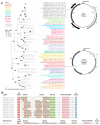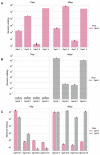New World Cactaceae Plants Harbor Diverse Geminiviruses
- PMID: 33923787
- PMCID: PMC8073023
- DOI: 10.3390/v13040694
New World Cactaceae Plants Harbor Diverse Geminiviruses
Abstract
The family Cactaceae comprises a diverse group of typically succulent plants that are native to the American continent but have been introduced to nearly all other continents, predominantly for ornamental purposes. Despite their economic, cultural, and ecological importance, very little research has been conducted on the viral community that infects them. We previously identified a highly divergent geminivirus that is the first known to infect cacti. Recent research efforts in non-cultivated and asymptomatic plants have shown that the diversity of this viral family has been under-sampled. As a consequence, little is known about the effects and interactions of geminiviruses in many plants, such as cacti. With the objective to expand knowledge on the diversity of geminiviruses infecting cacti, we used previously acquired high-throughput sequencing results to search for viral sequences using BLASTx against a viral RefSeq protein database. We identified two additional sequences with similarity to geminiviruses, for which we designed abutting primers and recovered full-length genomes. From 42 cacti and five scale insects, we derived 42 complete genome sequences of a novel geminivirus species that we have tentatively named Opuntia virus 2 (OpV2) and 32 genomes of an Opuntia-infecting becurtovirus (which is a new strain of the spinach curly top Arizona virus species). Interspecies recombination analysis of the OpV2 group revealed several recombinant regions, in some cases spanning half of the genome. Phylogenetic analysis demonstrated that OpV2 is a novel geminivirus more closely related to viruses of the genus Curtovirus, which was further supported by the detection of three recombination events between curtoviruses and OpV2. Both OpV2 and Opuntia becurtoviruses were identified in mixed infections, which also included the previously characterized Opuntia virus 1. Viral quantification of the co-infected cactus plants compared with single infections did not show any clear trend in viral dynamics that might be associated with the mixed infections. Using experimental Rhizobium-mediated inoculations, we found that the initial accumulation of OpV2 is facilitated by co-infection with OpV1. This study shows that the diversity of geminiviruses that infect cacti is under-sampled and that cacti harbor diverse geminiviruses. The detection of the Opuntia becurtoviruses suggests spill-over events between viruses of cultivated species and native vegetation. The threat this poses to cacti needs to be further investigated.
Keywords: Becurtovirus; Cactaceae; Geminiviridae; diversity; recombination.
Conflict of interest statement
The authors declare no conflict of interest.
Figures








Similar articles
-
A Novel Divergent Geminivirus Identified in Asymptomatic New World Cactaceae Plants.Viruses. 2020 Apr 3;12(4):398. doi: 10.3390/v12040398. Viruses. 2020. PMID: 32260283 Free PMC article.
-
Intergeneric recombination between a new, spinach-infecting curtovirus and a new geminivirus belonging to the genus Becurtovirus: first New World exemplar.Arch Virol. 2013 Nov;158(11):2245-54. doi: 10.1007/s00705-013-1733-4. Epub 2013 May 26. Arch Virol. 2013. PMID: 23708296
-
Establishment of three new genera in the family Geminiviridae: Becurtovirus, Eragrovirus and Turncurtovirus.Arch Virol. 2014 Aug;159(8):2193-203. doi: 10.1007/s00705-014-2050-2. Epub 2014 Mar 22. Arch Virol. 2014. PMID: 24658781
-
From Spatial Metagenomics to Molecular Characterization of Plant Viruses: A Geminivirus Case Study.Adv Virus Res. 2018;101:55-83. doi: 10.1016/bs.aivir.2018.02.003. Epub 2018 May 7. Adv Virus Res. 2018. PMID: 29908594 Review.
-
Geminiviruses: Taxonomic Structure and Diversity in Genomic Organization.Recent Pat Biotechnol. 2020;14(2):86-98. doi: 10.2174/1872208313666191203100851. Recent Pat Biotechnol. 2020. PMID: 31793424 Review.
Cited by
-
Two Novel Geminiviruses Identified in Bees (Apis mellifera and Nomia sp.).Viruses. 2024 Apr 13;16(4):602. doi: 10.3390/v16040602. Viruses. 2024. PMID: 38675943 Free PMC article.
-
Identification of the Begomoviruses Squash Leaf Curl Virus and Watermelon Chlorotic Stunt Virus in Various Plant Samples in North America.Viruses. 2021 Apr 30;13(5):810. doi: 10.3390/v13050810. Viruses. 2021. PMID: 33946382 Free PMC article.
-
Discovery and Genome Characterization of Three New Rhabdoviruses Infecting Passiflora spp. in Brazil.Viruses. 2025 May 19;17(5):725. doi: 10.3390/v17050725. Viruses. 2025. PMID: 40431736 Free PMC article.
-
Natural or artificial: An example of topographic spatial distribution analysis of mescaline in cactus plants by matrix-assisted laser desorption/ionization mass spectrometry imaging.Front Plant Sci. 2023 Feb 10;14:1066595. doi: 10.3389/fpls.2023.1066595. eCollection 2023. Front Plant Sci. 2023. PMID: 36844095 Free PMC article.
References
-
- Anderson E.F. The Cactus Family. Timber Press; Portland, OR, USA: 2001. p. 776.
-
- Ortega-Baes P., Godínez-Alvarez H. Global diversity and conservation priorities in the Cactaceae. Biodivers. Conserv. 2006;15:817–827. doi: 10.1007/s10531-004-1461-x. - DOI
Publication types
MeSH terms
LinkOut - more resources
Full Text Sources
Other Literature Sources
Research Materials

